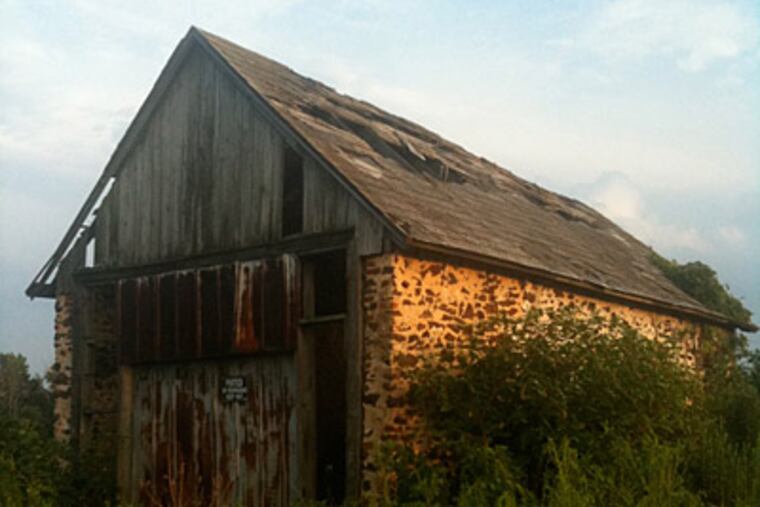Iconic barn to survive with help of Moorestown community
No one famous lived there and nothing of historic importance took place there. The building of Jersey sandstone on Westfield Road in Moorestown isn't even particularly attractive.

No one famous lived there and nothing of historic importance took place there. The building of Jersey sandstone on Westfield Road in Moorestown isn't even particularly attractive.
But generations of township residents have looked on it affectionately as a symbol of the community's farming heritage - and a simpler time.
As Moorestown has changed since the mid-19th century, the increasingly bedraggled Swede's Run barn became a gathering place, showing up like an old friend in the background of family and wedding pictures, as the site of parties, and the subject of paintings and artistic photos.
Now, thanks to the community's help, the iconic building should be around for snapshots and good times to come.
Supporters, working with the Historical Society of Moorestown, raised funds for a new $24,000 roof, which was completed in the spring.
They plan to replace the barn's doors and regrade the land around it as they seek a future role for the structure in township events, said Julie Maravich, project coordinator and a historical society member.
"When I came here from Charleston, S.C., 15 years ago, it was love at first sight," Maravich said of the barn.
"Even with the roof caving in, it was so charming and timeless. But I was always in a panic that someone would tear it down."
The site was part of a large tract that was subdivided and passed back and forth for 200 years among members of the Lippincott family and their in-laws.
Edmund Hackney, the first listed owner, took possession of the property in the 18th century, historical society records show. The last were Reuben and Carol Benner, who sold it in 2001 to Moorestown, which bought it as open space with funds from the township, Burlington County, and the state's Green Acres program.
On the site was the 16-by-27-foot stone barn - one of the last of its kind in the community, with 14-inch-thick mortared rubble walls. Historians believe it's at least 150 years old.
"It's a survivor, and that's one of the most important things about it," said professional historian Paul Schopp of Riverton. "It speaks of an agrarian economy instead of a business economy."
The barn "is from an age before McMansions, when farmers raised their crops and livestock," he said. "It's amazing that it's survived."
Bits of the past have been found on the tract.
"For thousands of years before the barn, Native Americans used the landscape for hunting and gathering," said professional archaeologist Jack Cresson, a Moorestown resident for 37 years. "I found pieces of weapon tips, cobble tools, and ceramics."
Closer to the building, he located glazed earthenware, glass, and nails from the 18th and 19th century.
The barn is "a type of building that there used to be plenty of," Maravich said. "It was surrounded by trees, then cleared for farm land."
It may have been attached to a frame farmhouse in the 1800s and used to store vegetables, or as a cold "keeping room" for milk, cream, and butter, the historical society said. The house was torn down, and the building stored a tractor, it's believed.
The cost of refurbishing the structure - estimated at $160,000 - was more than the township wanted to pay when it purchased the property. Residents heard talk of demolition and banded together to try to save it.
"There's just such an affection for the barn," Maravich said. The campaign became "a communitywide effort."
"If you tore it down, it would be just a big empty field," she said. Today, "there's a walking trail of gravel around the perimeter of the open space, which is about 120 acres."
The barn is the pastoral focal point of the tract, which is bordered by wildflowers and a crop of soy beans.
"Though I have a personal interest in the Swede's Run barn because my grandparents were the last private owners of the farm, my interest goes way beyond my family history," said Patricia Benner, a stream ecologist and river historian who lives in Corvallis, Ore. "I value historical structures because they provide a sense of place and sense of the community."
Last year, Maravich and others began to raise money for the renovations. The structure was featured in images taken by local photographer Jan Daniels, and prints and barn-themed coffee-table books were sold to bring in funds. Cresson offered watercolor paintings of the barn for sale.
Individual and business donations also came in as supporters alerted the public. About $12,000 is still owed for the roof, Maravich said.
"It's just knowing that [the barn] is preserved in open space," Cresson said. "I'd much rather see the barn than just grass."
The Swede's Run barn "is a link to our past," Benner said, "but also will be a link to the future.